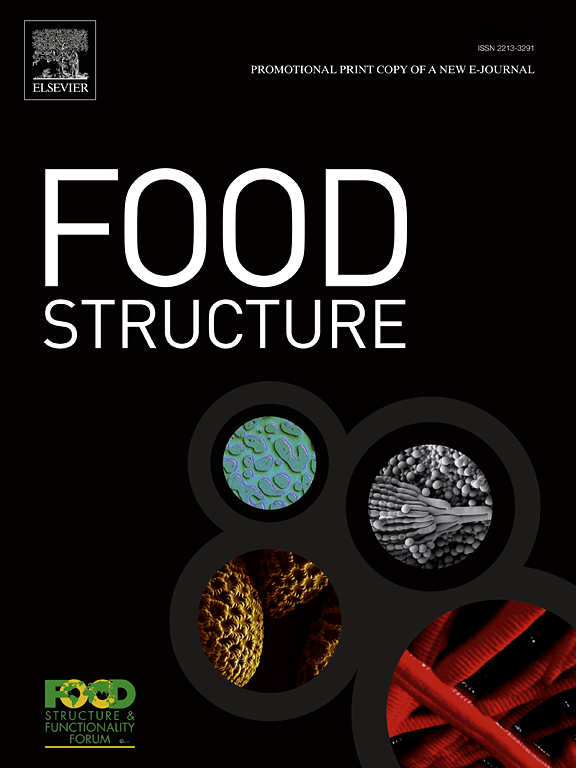高强度超声对植物甾醇基油凝胶发育的影响
IF 5.9
3区 农林科学
Q1 FOOD SCIENCE & TECHNOLOGY
引用次数: 0
摘要
油结构提供了一种高饱和脂肪的替代品,在过去十年中得到了极大的关注。由于其低饱和脂肪含量和健康益处,植物甾醇是一种很有前途的油凝胶剂。然而,它们很难在低浓度下有效地构造液体油。高强度超声(HIU)已显示出通过空化增强油凝胶物理性质的潜力。本研究旨在利用植物甾醇在含HIU和不含HIU的菜籽油中制备油凝胶,并评估其物理性质。商品甾醇(10 %w/w)与菜籽油混合。一个样本作为没有HIU的对照,而其他样本在不同的幅度和持续时间进行HIU治疗。在20°C下加热24 小时后,分析样品的显微镜、油结合能力、熔化行为、多态性、硬度、粘度和粘弹性。HIU产生了单一的熔化峰,减小了晶体尺寸,降低了油损失。它还增强了硬度、粘度和粘弹性,主要在较长时间(10 s)超声处理的样品中观察到显著的改善,无论振幅如何。最显著的结果是10 s脉冲处理(5 s ON/5sOFF/5sON),振幅为50 %,在没有相分离的情况下保持了30天的油凝胶稳定性。因此,HIU是一种可行的、环保的方法,可以增强植物甾醇油凝胶的物理性质,从而实现有效的油结构。本文章由计算机程序翻译,如有差异,请以英文原文为准。
Impact of high-intensity ultrasound on the development of phytosterol-based oleogels
Oil structuration offers an alternative to high saturated fats and has gained significant attention over the past decade. Phytosterols present a promising option as oleogelators due to their low saturated fat content and health benefits. However, they struggle to effectively structure liquid oils at low concentrations. High-Intensity Ultrasound (HIU) has shown potential to enhance oleogels physical properties through cavitation. This study aims to use phytosterols to create oleogels in rapeseed oil, both with and without HIU, and assess their physical properties. Commercial sterols (10 %w/w) were mixed with rapeseed oil. One sample served as a control without HIU, while others were treated with HIU at various amplitudes and durations. After 24 hours at 20°C, samples were analyzed for microscopy, oil binding capacity, melting behavior, polymorphism, hardness, viscosity, and viscoelasticity. HIU produced a single melting peak, reduced crystal size, and decreased oil loss. It also enhanced hardness, viscosity, and viscoelasticity, with significant improvements observed primarily in samples sonicated for longer durations (10 s), regardless of amplitude. The most notable results were from a 10 s pulse treatment (5 s ON/5sOFF/5sON) at 50 % amplitude, which maintained the oleogel stability for 30 days without phase separation. Thus, HIU is a viable, eco-friendly method to enhance phytosterol oleogels physical properties, allowing for effective oil structuration.
求助全文
通过发布文献求助,成功后即可免费获取论文全文。
去求助
来源期刊

Food Structure-Netherlands
Chemical Engineering-Bioengineering
CiteScore
7.20
自引率
0.00%
发文量
48
期刊介绍:
Food Structure is the premier international forum devoted to the publication of high-quality original research on food structure. The focus of this journal is on food structure in the context of its relationship with molecular composition, processing and macroscopic properties (e.g., shelf stability, sensory properties, etc.). Manuscripts that only report qualitative findings and micrographs and that lack sound hypothesis-driven, quantitative structure-function research are not accepted. Significance of the research findings for the food science community and/or industry must also be highlighted.
 求助内容:
求助内容: 应助结果提醒方式:
应助结果提醒方式:


